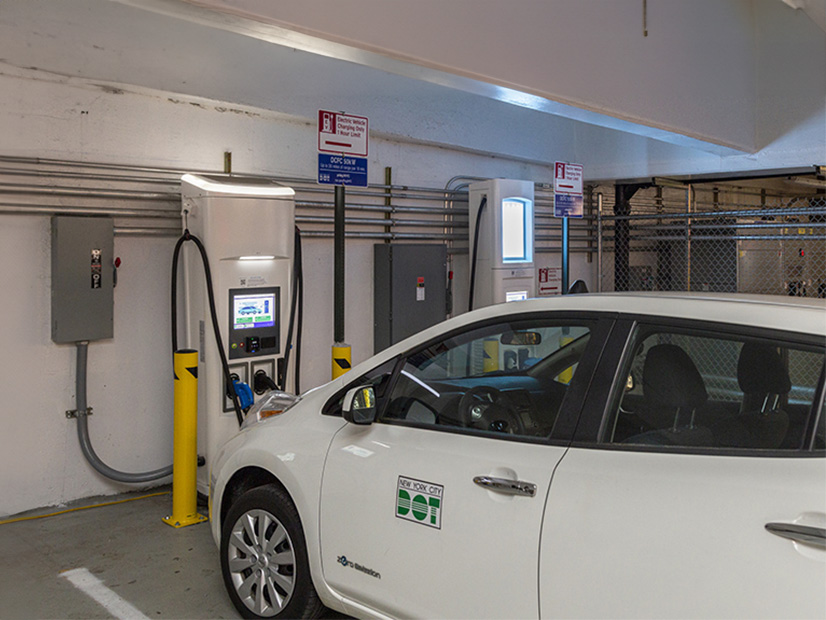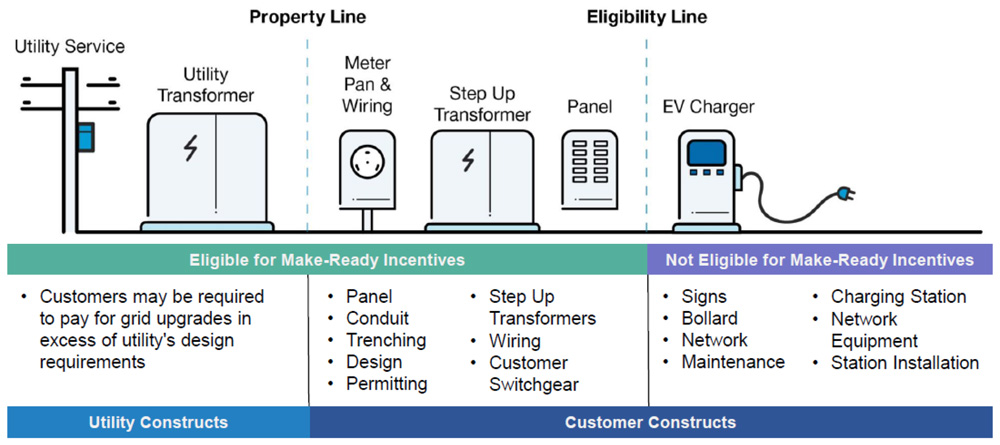ALBANY, N.Y. — New York on Thursday significantly increased its commitment to its electric vehicle charging infrastructure, boosting the EV Make-Ready Program’s budget from $701 million to $1.24 billion (18-E-0138).
At its Nov. 16 meeting, the New York Public Service Commission (PSC) endorsed the recommendations of the Department of Public Service’s (DPS) Make-Ready midpoint review whitepaper, which called for new programs and changing the mix of Level 2 and DC Fast Chargers (DCFC).
Launched in 2020, the Make-Ready program subsidizes 50% to 100% of costs to make a site ready for EV charging, including equipment on the utility and customer sides of the meter. It is overseen by the DPS but primarily executed by six of New York’s utilities.
As of the midpoint review, the six investor-owned utilities have committed or completed 12,475 L2 chargers (23% of the original goal of 53,770) and 630 of the planned 1,500 DC Fast Chargers (42%).
DPS acknowledged the state’s EV growth has not kept pace with the goals of the Climate Leadership and Community Protection Act (CLCPA). The state currently has about 175,000 electric or plug-in hybrids, far below the CLCPA’s goal of 850,000 by 2025.
The PSC order reflects higher costs — increasing L2 chargers by up to 37% and nearly doubling estimates for DCFC. It also changes the mix of chargers
The PSC had assumed that 57% of New York City residents and 82% of those outside the city have some access to residential charging. The commission’s new forecast assumes that early adopters — those purchasing EVs through 2025 — will have greater access to residential charging options than the population at large, with 77% of early adopters in New York City and 95% those outside have access to residential charging.
As a result of the new data, the PSC changed the target for EV plug installations to 38,356 Level 2 (L2) plugs (down from 53,773) and 6,302 direct current fast charger (DCFC) plugs (up from 1,500).
The modified Make-Ready program also seeks to address infrastructure gaps and improve accessibility to disadvantaged communities (DACs). The PSC’s order:
-
- Allocates an extra $166 million for EV deployment in disadvantaged communities, taking the total to $327 million;
- Increases the budget for the medium- and heavy-duty (MHD) Make-Ready pilot to $67 million;
- Creates a $25 million program focusing on DACs to provide micromobility charging — lightweight, low-speed devices, such as electric bikes and electric scooters; and
- Extends the Make-Ready program’s deadline beyond Jan. 1, 2025, if the plug targets remain unmet.
The commission also created a stakeholder-led process to address issues related to EV charging projects stuck in interconnection queues and directed Consolidated Edison to increase the allowable output per charging site to 6 MW,
The PSC’s order also directed the utilities to standardize data collection and reporting, to ensure curbside chargers are limited to EV charging-only parking spaces and to display contact information for EV servicing at all program-funded charging sites.
The budget increase is expected to increase ratepayer bills by 0.7% to 1.7%, depending on the utility. The expanded investment should stimulate an additional $4 billion in EV and infrastructure investments, Gov. Kathy Hochul (D) said in a press release.
PSC Questions & Comments
Before voting to expand the Make-Ready program, the commissioners raised questions about accessibility, micromobility and infrastructure.
Commissioner Diane Burman voiced concerns about the whitepaper’s recommendation for a subgroup focusing on the interconnection queue.
Zeryai Hagos, DPS’s deputy director of the Office of Markets and Innovation, explained the new EV Infrastructure Interconnection Working Group (EVIIWG) would investigate new processes that might help EV charging projects get through interconnection queues more quickly. The staff whitepaper said the working group would be similar to two initiatives that helped eliminate a backlog of distributed energy resource (DER) applications in interconnection queues.
Burman next inquired about the directive calling on Con Edison, which is installing about one third of the EV chargers statewide, to submit a proposal to streamline its queue management for EVs and why it was chosen for this task versus other utilities.
Hagos replied that ConEd’s experience in New York City could offer a statewide model for EV improvements and deployment. Burman accepted this argument but commented, “one size doesn’t fit all.”
Burman sought assurances that PSC funding would both address traffic and safety concerns raised around micromobility vehicles and that any funding would be directed to the DACs where these smaller E-bikes or scooters are most often used.
Jen Roberton, transportation lead at DPS, acknowledged traffic safety issues and fire concerns over micromobility vehicles, while highlighting the program’s focus on providing charging infrastructure in DACs, particularly for the 60,000 plus food delivery workforce operating E-bikes and scooters in New York City.
Burman also questioned the program’s limitations on energy storage devices paired with EVs, saying “we may be missing the mark” by preventing them from being used for backup power.
Roberton acknowledged potential lost opportunities but said the PSC was attempting to avoid “double incentivizing” storage.
“We have other programs that support storage [and] we don’t want to have site hosts … access some of our storage-related incentives administered by utilities and then also get an incentive to make-ready,” Roberton said. “So the intent was to make sure that the incentives were going to the right place.”
Commissioner John Howard asked about New York’s progress toward its EV adoption goals and if staff thought the state was on track to achieve its CLCPA goal of having 850,000 EVs by 2025.
Hagos said the state will not meet the 2025 goal, saying supply chain disruptions during the COVID-19 pandemic and domestic content rules in the Inflation Reduction Act slowed EV adoption. But he said the state could reach its 850,000 target by 2026 or 2027.
Howard also expressed concern about the reliability of EV chargers, saying as many as one in four of New York’s fleet do not work on a given day.
Roberton concurred this is a considerable barrier to EV adoption. DPS is adopting national reliability standards to improve its data collection.
On micromobility, Howard urged more direct engagement with fire stations to address concerns about battery explosions and fires involving E-bikes and scooters. Roberton confirmed the DPS has ongoing discussions with fire departments over micromobility safety.
Other commissioners placed the PSC’s approval and status of the Make-Ready program into the wider perspective.
“This is very ambitious, and at some point, I think ambition and reality will come face-to-face,” said Commissioner James Alesi. “I hope that ambition prevails.”
Commissioner John Maggiore highlighted the roadblocks confronting New York as it transitions its fleet of vehicles to EVs, but expressed optimism, saying “we are going to encounter other difficulties, but it’s a noble goal, and I think we are going to achieve the goal.”
Reaction
Environmental groups, EV operating and charging infrastructure companies, and community leaders, were equally optimistic, welcoming the PSC’s decision to approve the midpoint review and order more investment into the Make-Ready program.
Jason Zarillo, president of Livingston Energy Group, an EV infrastructure installation and management company, said the order will drive more EV investment and create jobs as well as enable consumers to “feel confident in purchasing EVs.”
Frank Reig, CEO of Revel, which runs an electric moped sharing service in New York City, said, “the door to EVs in New York” has been opened. He said his company is committed to “bringing the largest network of public fast charging infrastructure to the communities that will benefit most from zero emission EVs.”
Caroline Samponaro, VP of micromobility policy at ride-sharing company Lyft, also hailed the continued EV investment, saying it, “will help break down the primary barriers to widespread EV adoption.”
Pamela MacDougall, director of grid modernization strategy at the Environmental Defense Fund, commended the PSC for “continuing to prioritize vehicle charging and significantly expanding accessibility of funds to disadvantaged communities.”


